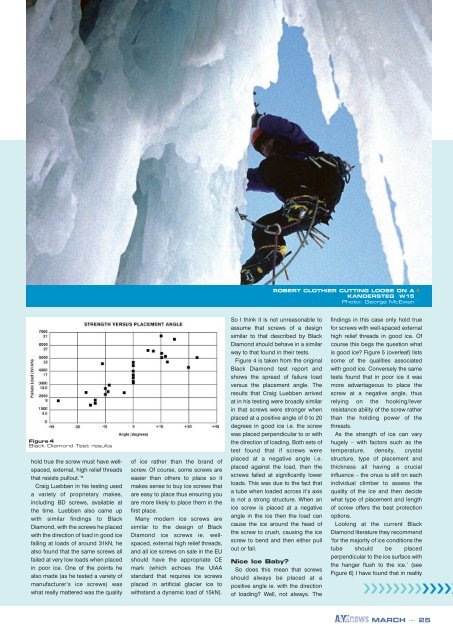AMI NEWSLETTER - George McEwan on ... - Glenmore Lodge
AMI NEWSLETTER - George McEwan on ... - Glenmore Lodge
AMI NEWSLETTER - George McEwan on ... - Glenmore Lodge
Create successful ePaper yourself
Turn your PDF publications into a flip-book with our unique Google optimized e-Paper software.
Figure 4<br />
Black Diam<strong>on</strong>d Test results<br />
hold true the screw must have wellspaced,<br />
external, high relief threads<br />
that resists pullout.’*<br />
Craig Luebben in his testing used<br />
a variety of proprietary makes,<br />
including BD screws, available at<br />
the time. Luebben also came up<br />
with similar findings to Black<br />
Diam<strong>on</strong>d, with the screws he placed<br />
with the directi<strong>on</strong> of load in good ice<br />
failing at loads of around 31kN, he<br />
also found that the same screws all<br />
failed at very low loads when placed<br />
in poor ice. One of the points he<br />
also made (as he tested a variety of<br />
manufacturer’s ice screws) was<br />
what really mattered was the quality<br />
of ice rather than the brand of<br />
screw. Of course, some screws are<br />
easier than others to place so it<br />
makes sense to buy ice screws that<br />
are easy to place thus ensuring you<br />
are more likely to place them in the<br />
first place.<br />
Many modern ice screws are<br />
similar to the design of Black<br />
Diam<strong>on</strong>d ice screws ie. wellspaced,<br />
external high relief threads,<br />
and all ice screws <strong>on</strong> sale in the EU<br />
should have the appropriate CE<br />
mark (which echoes the UIAA<br />
standard that requires ice screws<br />
placed in artificial glacier ice to<br />
withstand a dynamic load of 15kN).<br />
ROBERT CLOTHIER CUTTING LOOSE ON A ▲<br />
KANDERSTEG W15<br />
Photo: <str<strong>on</strong>g>George</str<strong>on</strong>g> <str<strong>on</strong>g>McEwan</str<strong>on</strong>g><br />
So I think it is not unreas<strong>on</strong>able to<br />
assume that screws of a design<br />
similar to that described by Black<br />
Diam<strong>on</strong>d should behave in a similar<br />
way to that found in their tests.<br />
Figure 4 is taken from the original<br />
Black Diam<strong>on</strong>d test report and<br />
shows the spread of failure load<br />
versus the placement angle. The<br />
results that Craig Luebben arrived<br />
at in his testing were broadly similar<br />
in that screws were str<strong>on</strong>ger when<br />
placed at a positive angle of 0 to 20<br />
degrees in good ice i.e. the screw<br />
was placed perpendicular to or with<br />
the directi<strong>on</strong> of loading. Both sets of<br />
test found that if screws were<br />
placed at a negative angle i.e.<br />
placed against the load, then the<br />
screws failed at significantly lower<br />
loads. This was due to the fact that<br />
a tube when loaded across it’s axis<br />
is not a str<strong>on</strong>g structure. When an<br />
ice screw is placed at a negative<br />
angle in the ice then the load can<br />
cause the ice around the head of<br />
the screw to crush, causing the ice<br />
screw to bend and then either pull<br />
out or fail.<br />
Nice Ice Baby?<br />
So does this mean that screws<br />
should always be placed at a<br />
positive angle ie. with the directi<strong>on</strong><br />
of loading? Well, not always. The<br />
findings in this case <strong>on</strong>ly hold true<br />
for screws with well-spaced external<br />
high relief threads in good ice. Of<br />
course this begs the questi<strong>on</strong> what<br />
is good ice? Figure 5 (overleaf) lists<br />
some of the qualities associated<br />
with good ice. C<strong>on</strong>versely the same<br />
tests found that in poor ice it was<br />
more advantageous to place the<br />
screw at a negative angle, thus<br />
relying <strong>on</strong> the hooking/lever<br />
resistance ability of the screw rather<br />
than the holding power of the<br />
threads.<br />
As the strength of ice can vary<br />
hugely – with factors such as the<br />
temperature, density, crystal<br />
structure, type of placement and<br />
thickness all having a crucial<br />
influence – the <strong>on</strong>us is still <strong>on</strong> each<br />
individual climber to assess the<br />
quality of the ice and then decide<br />
what type of placement and length<br />
of screw offers the best protecti<strong>on</strong><br />
opti<strong>on</strong>s.<br />
Looking at the current Black<br />
Diam<strong>on</strong>d literature they recommend<br />
‘for the majority of ice c<strong>on</strong>diti<strong>on</strong>s the<br />
tube should be placed<br />
perpendicular to the ice surface with<br />
the hanger flush to the ice.’ (see<br />
Figure 6) I have found that in reality<br />
❯❯❯❯❯❯❯❯❯❯❯❯❯<br />
<str<strong>on</strong>g>AMI</str<strong>on</strong>g>news MARCH ... 25



